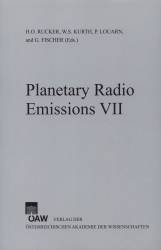
Planetary Radio Emissions VII, pp. 179-186, 2011/12/28
Proceedings of the 7th International Workshop on Planetary, Solar and Heliospheric Radio Emissions held at Graz, Austria, September 15–17, 2010

It has long been recognized that there is a marked long-term periodic variation in Jupiter’s integrated radio occurrence probability. The period of the variation is on the order of a decade. Carr et al. [1970] showed that such variations are closely correlated with Jovicentric declination of the Earth (DE). The range of the smoothed variation of DE is from approximately +3.3 to -3.3 degrees. This DE effect was extensively studied and confirmed by Garcia [1996]. It shows that the occurrence probability of the non-Io-A source is clearly controlled by DE at 18, 20, and 22 MHz during the 1957-1994 apparitions. We propose a new model to explain the DE effect. This new model shows that the beam structure of Jupiter radio emissions, which has been thought of like a hollow-cone, has a narrow beam like a searchlight, which can be explained by assuming that the three dimensional shape of the radio source expands along the line of the magnetic field. If we consider the sizes of the radio coherent region are 1000 m along Jupiter’s magnetic field line and 200 m along the latitudinal direction, the equivalent beam pattern is 1 degree wide along Jupiter’s magnetic field line and 5 degrees in latitude. As the searchlight beam is fixed with Jupiter’s magnetic field, the pure geometrical effect of DE can be explained by this searchlight beam model.